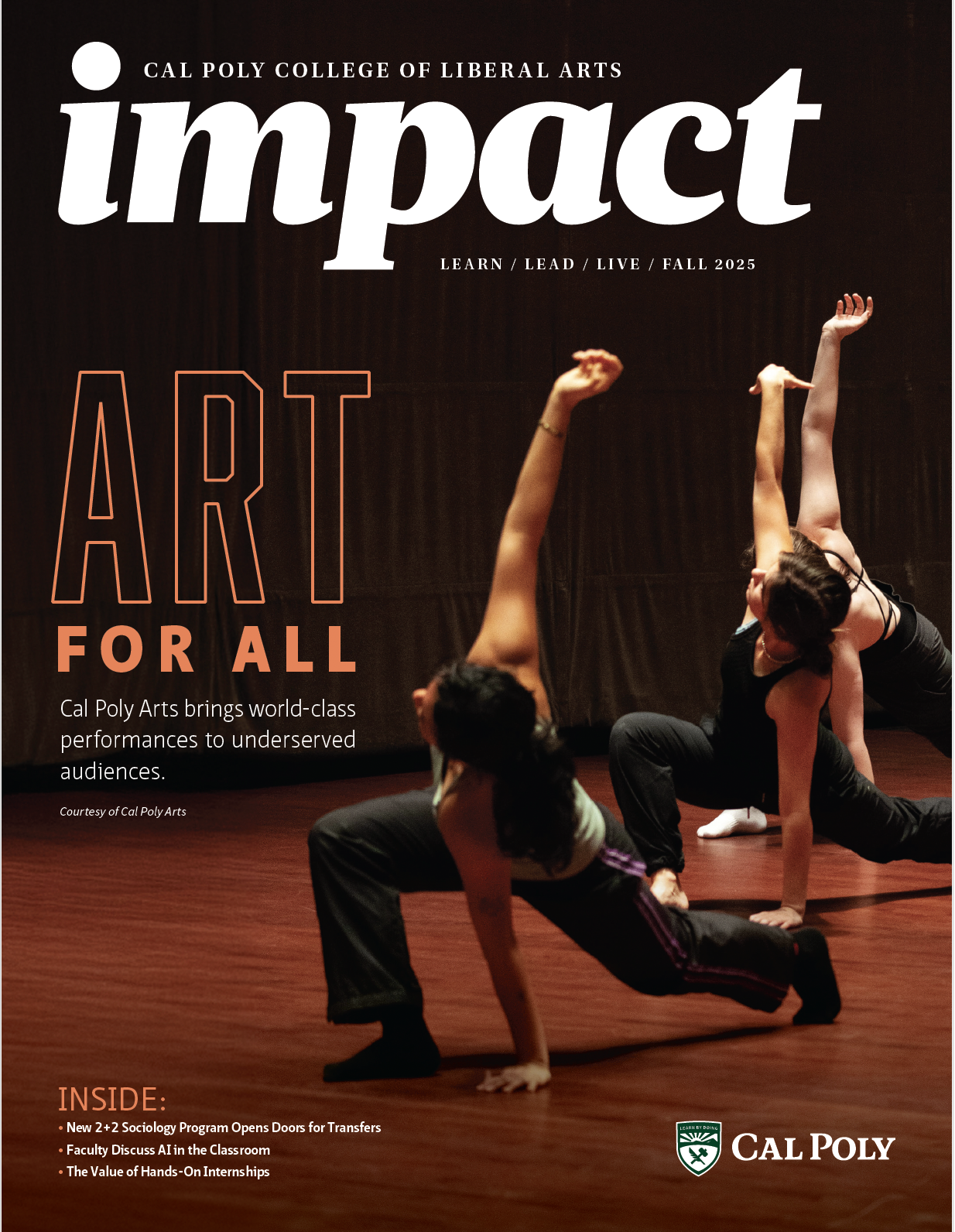Art as Activism
Asian Pacific Islander Desi American (APIDA) students from across the college are using art to build inclusive spaces for intersecting identities.

Halle Gotico and her completed utility box mural.
Halle Fernandez Gotico double majored in comparative ethnic studies and history (’23) with a minor in law and society. She served as co-president of the Pilipino Cultural Exchange Club and an organizer for the two-day Pilipino Cultural Night performance.
For a public history course, Gotico designed and painted a tribute to the first Filipino landing at Morro Bay through Cal Poly’s campus utility box beautification project. Inspired by a Morro Bay memorial marker from the Filipino American National Historical Society, Gotico saw an opportunity to share a little-known piece of local history.
“My own personal experiences as a Filipina American inspired me to find ways to increase Filipinx representation and strengthen the APIDA community in any way I could,” Gotico said. “From asking for feedback about how to honor the yak tityu tityu yak tiłhini (ytt) Northern Chumash to inviting members of the Filipinx and APIDA communities to help in painting, I have learned how to adapt my project to better represent the people it is meant for. As someone who has always been fascinated by the intersections of the legal system, history and the education system, I’m hoping to pursue a career in law advocating for students and communities. With this being one of the largest community projects I have ever led, this process has provided me with key insight into things to consider when representing others.”

Attendees enjoy art and atmosphere at "Common Ground."
Euree Hong (Sociology, ’23) used her senior project to showcase 11 queer and BIPOC San Luis Obispo County artists by organizing an art show, “Common Ground,” celebrating intersecting identities.
“‘Common Ground’ recognizes the necessity of shared social spaces in San Luis Obispo, specifically for the queer/BIPOC community,” Hong said. “Within my college experience, I’ve noticed that the multiple facets of my identity and interests are fractioned into separate communities. Spaces can feel monolithic and confining when gender, racial and socioeconomic dynamics at play are not recognized or, worse, treated as nonexistent. In an effort towards equity and inclusion, ‘Common Ground’ was a night where our community gathered to express, receive, and bond over identity and creativity.”
Hong took charge of recruiting artists, finding a venue and opening entertainment, and contacting local media outlets to garner more publicity for the featured artists. The show raised funds for local non-profit organizations (Race Matters SLO and Asian American Pacific Islanders of SLO) actively working on race-related issues.
“I feel grateful to have been able to organize a successful night filled with art, laughter and hope. I want to thank everyone who said yes along the way. I think many people who attended this event recognized the lack of designated spaces where identity, art and social justice issues merge in San Luis Obispo. Although ‘Common Ground’ was a one-night event, I hope this inspires continuity of this dialogue,” Hong said.

Yvonne Bee, left, and Halle Fernandez Gotico.
Yvonne Bee (English, ’23, women’s and gender studies minor) used art as a form of activism across a wide range of media, including curating an art gallery for OWN (Original Womxn’s Narratives), writing, editing and designing graphics for Revel magazine, and editing student-run publications Intertidal and sprinkle.
“I thoroughly enjoyed bringing my WGS scholarship in conversation with my English course texts to address the inequities of feminist, queer writers and the problematic tropes written by cis-hetero white men,” Bee said. “The term ‘artivism’ encapsulates art as a medium of self-expression and social change. Art allows artists to show their multifaceted identities while reclaiming their narratives. As a hobbyist artist, I enjoy abstract elements incorporating my Mandarin, Cantonese and English languages together for a larger impact. It’s therapeutic for me, and I enjoy seeing how viewers all take away a different message of calls for social reform.”
Bee cites the COVID-19 pandemic as a motivating force to keep learning and getting involved with social justice organizations, which ultimately helped her to graduate a year early. “While my time at Cal Poly included many extracurriculars, I credit my professors, mentors and work coordinators for looking into alternative approaches to my projects and more flexible workloads. I often wonder if it’s possible to change some aspects of campus climate, and to an extent, I did,” Bee said.
 Download a a pdf of IMPACT magazine.
Download a a pdf of IMPACT magazine.

